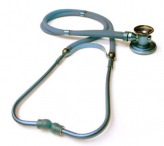My teaching philosophy
I think of learning as a process of exploration, so as a teacher I function as a tour guide. Language consists of four domains: speaking, listening, reading, and writing. Students need experience in all of them to develop as proficient users of the language. My job is to provide students opportunities in each of these domains so they can experience and use Spanish and English in authentic ways. An hour a day is not a lot of time to do this, so I plan to maximize my time with my students by using the language that students are learning as much as possible, switching to the students' first language only when I can justify it. I believe that grammar is a vehicle for communication, not an end in itself. With this in mind, students will frequently demonstrate their proficiency in the phonology, morphology, syntax, semantics, and pragmatics of their new language through products like skits, essays, presentations, and posters.
My Lessons
These lessons demonstrate my use of inductive methods. Induction is a powerful teaching method because it shows students multiple examples and encourages them to look for a rule. When students think critically on their own, they are more likely to understand and remember the rule once it is presented.
Inductive grammar lesson: Posesión en español
This lesson uses a powerpoint to inductively present the rule for inflecting possessive adjectives, then provides students with a chance to practice.
Inductive pronunciation lesson: Las vocales del español
I noticed that many of my students were transferring their knowledge of English vowels to Spanish and wanted to develop a more native-like understanding, so I designed this lesson around the idea that Spanish only has five vowels, each of which is represented by only one letter (in contrast to English, which is much more complicated). This lesson is designed to help students realize this through a comparison of English and Spanish, listening to Spanish vowels, establishing a rule, and practice with words and tongue twisters. See the worksheet for more details.
My Units
El buen comer es un arte
Students learn about ingredients and recipes, command forms, menus, regional food, restaurants, and using the conditional to soften requests. Includes a technology-based plan, substitute plan, restaurant simulation assessment plan, and final examination. Click on the title to link to a website with the plans and materials.
La medicina

Writing a story using medical vocabulary
First, I told students a short story, all in Spanish, using sketches that I had drawn myself. Then the students worked in groups to write stories using their medical vocabulary, make illustrations, and present their story to the class. They were able to practice listening, writing, and speaking through this activity. I´ve included some sample pictures that the students made.
Filling out an authentic medical history form
Students received copies of a medical history form. First, I reviewed the meaning of the present perfect, how to form it, and how to interpret questions that used it. In this way, I was able to integrate grammar into the unit in a natural, useful way. Then the students filled out the form for a fictional character. Last, they did a role play of a medical interview, pretending to be a doctor and asking their classmates for their health information. The activity incorporates elements of reading, writing, speaking, and listening.
A vocabulary quiz
This short quiz tested students´ knowledge of vocabulary through connections with other words in Spanish or with pictures, rather than more traditional English/Spanish matching methods. I believe in using as much Spanish as possible, and quizzes like this are one way that I can minimize the use of English in my classes.
Presenting a newspaper article
This project-based assessment was a grade about half the size of the unit test. I believe projects can be effectively used for students to learn and to show what they have learned. I proceeded as follows.
1. I presented the students with the procedure and requirements for the project, which are written entirely in Spanish. We walked through them together. The students had to work in pairs to find and read an article in Spanish about a medical issue in a Spanish-speaking country. Then they would make a powerpoint presentation to present the main idea of the article to the class.
2. I presented a sample powerpoint about HIV in Ecuador, both to inform the students about the topic and to make my expectations for the project clear.
3. The students had several days to use the computers in class to find their article, read it, and make the powerpoint.
4. Students presented their articles to the class. They had to incorporate four questions about the article into the powerpoint to check their classmates´ comprehension. This kept students accountable, as I included these questions on the unit test. I learned a great deal from the presentations, and I´m sure that the students did, too.
Unit Test
The test included a comprehension section to check their recall of vocabulary in context, as well as a section to check their ability to form the present and past perfect, and a section containing the questions other students had included in their presentations. Unlike most of my materials, I have chosen not to post the test online because I am considering using a similar test with future classes.
